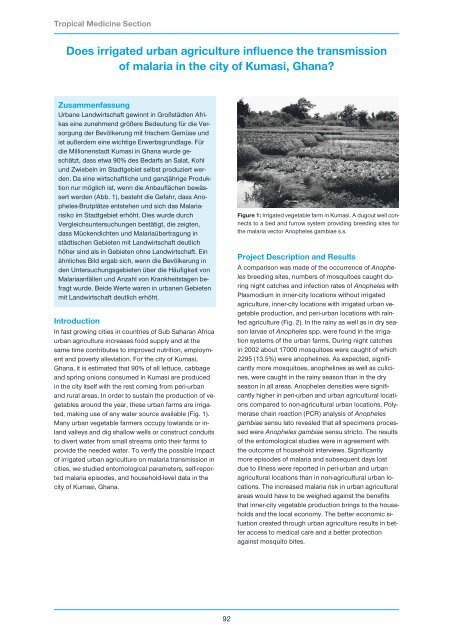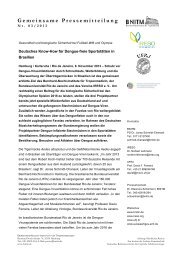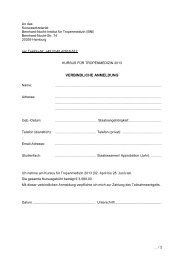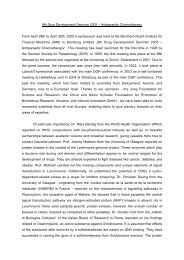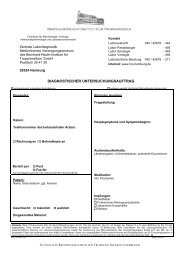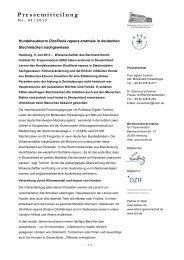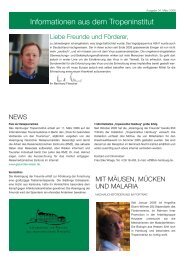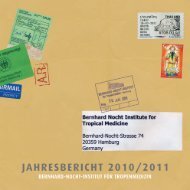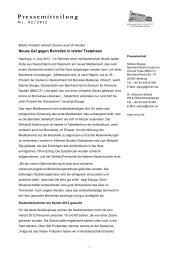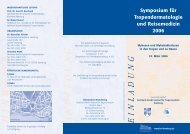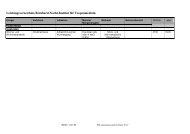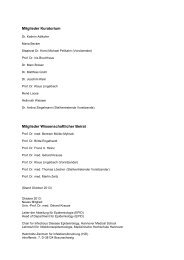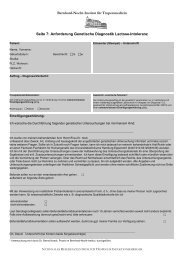Research Group Heussler (Malaria I) - Bernhard-Nocht-Institut für ...
Research Group Heussler (Malaria I) - Bernhard-Nocht-Institut für ...
Research Group Heussler (Malaria I) - Bernhard-Nocht-Institut für ...
Create successful ePaper yourself
Turn your PDF publications into a flip-book with our unique Google optimized e-Paper software.
Tropical Medicine Section<br />
Does irrigated urban agriculture influence the transmission<br />
of malaria in the city of Kumasi, Ghana?<br />
Zusammenfassung<br />
Urbane Landwirtschaft gewinnt in Großstädten Afrikas<br />
eine zunehmend größere Bedeutung <strong>für</strong> die Versorgung<br />
der Bevölkerung mit frischem Gemüse und<br />
ist außerdem eine wichtige Erwerbsgrundlage. Für<br />
die Millionenstadt Kumasi in Ghana wurde geschätzt,<br />
dass etwa 90% des Bedarfs an Salat, Kohl<br />
und Zwiebeln im Stadtgebiet selbst produziert werden.<br />
Da eine wirtschaftliche und ganzjährige Produktion<br />
nur möglich ist, wenn die Anbauflächen bewässert<br />
werden (Abb. 1), besteht die Gefahr, dass Anopheles-Brutplätze<br />
entstehen und sich das <strong>Malaria</strong>risiko<br />
im Stadtgebiet erhöht. Dies wurde durch<br />
Vergleichsuntersuchungen bestätigt, die zeigten,<br />
dass Mückendichten und <strong>Malaria</strong>übertragung in<br />
städtischen Gebieten mit Landwirtschaft deutlich<br />
höher sind als in Gebieten ohne Landwirtschaft. Ein<br />
ähnliches Bild ergab sich, wenn die Bevölkerung in<br />
den Untersuchungsgebieten über die Häufigkeit von<br />
<strong>Malaria</strong>anfällen und Anzahl von Krankheitstagen befragt<br />
wurde. Beide Werte waren in urbanen Gebieten<br />
mit Landwirtschaft deutlich erhöht.<br />
Introduction<br />
In fast growing cities in countries of Sub Saharan Africa<br />
urban agriculture increases food supply and at the<br />
same time contributes to improved nutrition, employment<br />
and poverty alleviation. For the city of Kumasi,<br />
Ghana, it is estimated that 90% of all lettuce, cabbage<br />
and spring onions consumed in Kumasi are produced<br />
in the city itself with the rest coming from peri-urban<br />
and rural areas. In order to sustain the production of vegetables<br />
around the year, these urban farms are irrigated,<br />
making use of any water source available (Fig. 1).<br />
Many urban vegetable farmers occupy lowlands or inland<br />
valleys and dig shallow wells or construct conduits<br />
to divert water from small streams onto their farms to<br />
provide the needed water. To verify the possible impact<br />
of irrigated urban agriculture on malaria transmission in<br />
cities, we studied entomological parameters, self-reported<br />
malaria episodes, and household-level data in the<br />
city of Kumasi, Ghana.<br />
92<br />
Figure 1: Irrigated vegetable farm in Kumasi. A dugout well connects<br />
to a bed and furrow system providing breeding sites for<br />
the malaria vector Anopheles gambiae s.s.<br />
Project Description and Results<br />
A comparison was made of the occurrence of Anopheles<br />
breeding sites, numbers of mosquitoes caught during<br />
night catches and infection rates of Anopheles with<br />
Plasmodium in inner-city locations without irrigated<br />
agriculture, inner-city locations with irrigated urban vegetable<br />
production, and peri-urban locations with rainfed<br />
agriculture (Fig. 2). In the rainy as well as in dry season<br />
larvae of Anopheles spp. were found in the irrigation<br />
systems of the urban farms. During night catches<br />
in 2002 about 17000 mosquitoes were caught of which<br />
2295 (13.5%) were anophelines. As expected, significantly<br />
more mosquitoes, anophelines as well as culicines,<br />
were caught in the rainy season than in the dry<br />
season in all areas. Anopheles densities were significantly<br />
higher in peri-urban and urban agricultural locations<br />
compared to non-agricultural urban locations. Polymerase<br />
chain reaction (PCR) analysis of Anopheles<br />
gambiae sensu lato revealed that all specimens processed<br />
were Anopheles gambiae sensu stricto. The results<br />
of the entomological studies were in agreement with<br />
the outcome of household interviews. Significantly<br />
more episodes of malaria and subsequent days lost<br />
due to illness were reported in peri-urban and urban<br />
agricultural locations than in non-agricultural urban locations.<br />
The increased malaria risk in urban agricultural<br />
areas would have to be weighed against the benefits<br />
that inner-city vegetable production brings to the households<br />
and the local economy. The better economic situation<br />
created through urban agriculture results in better<br />
access to medical care and a better protection<br />
against mosquito bites.


